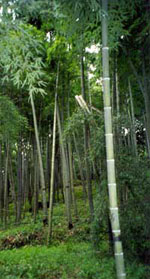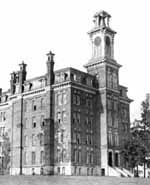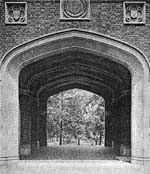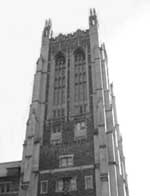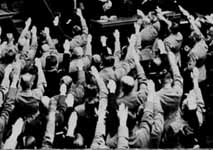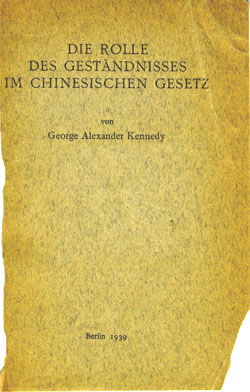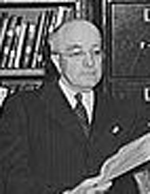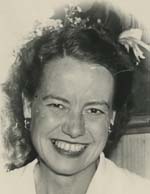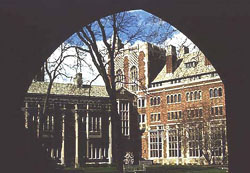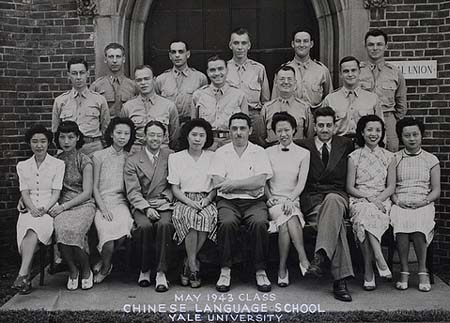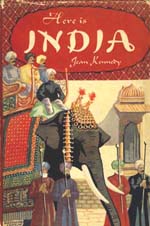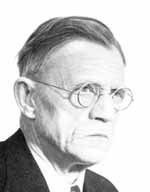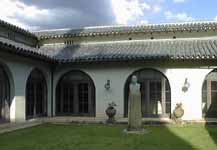Sinological Profiles
George A Kennedy
17 May 1901 (Mokanshan) - 15 Aug 1960 (at sea)Missionaries in the sultry parts of India and China often established what they called "hill stations" in elevated and thus healthier locations. One such was located at Mokanshan (30° 35´ N, 119° 47´ E), an outlying peak of the Tyen-mu Mountain group, just north of Wukang. It was convenient to Hangchow, and also served as a cool retreat for those based in Shanghai to the east and Nanking to the north. The days were still warm, in Mokanshan, but the nights were cool and restful. The center of the hilltop community was the Protestant church, which also served as a venue for dramatic and musical performances and as the site of Boy Scout and other meetings. A spot near the summit was terraced and leveled for a tennis court; the spectators sat on the terrace wall or in a covered bamboo pavilion. There were also hiking trails, winding among the green bamboos . . .
Like not a few missionary children of that time, George Alexander Kennedy was born at Mokanshan. His parents, Alexander and Ada Kennedy, missionaries from Nova Scotia and Rhode Island, respectively, had met in Tangsi, Chekiang, in June 1899 and had married in December of that year. A joint mission in Tangsi immediately resulted. In January of 1900 they held "the first meeting in our own home." In June of 1900, Alex's diary records "foundation for chapel done.” George, the couple's first child, followed soon after, on 17 May 1901. From 1902 on, the enterprise became formally known as the Grace Mission. It was supported by voluntary contributions rather than by any of the established Mission Boards. George acquired a younger brother Fred in 1904, and in 1906 a Miss Etchells came to assist at the Mission. Another brother, Donald, was born in 1908. George was an early and assiduous student. At seven, in the year of Donald's birth, George compiled a list of the books of the Bible with a two-line rhyme explaining each book. This list covered all of the Old Testament books, but progressed no further in the New than the Gospel of Matthew, thus for the time being avoiding the intellectual difficulties that can arise from considering the Synoptic Gospels together.
It was in Tangsi, in the Wu dialect area of China, not far north of Hangchow, that George grew up. He was later to turn to good account his native acquaintance with what he called "Tangsic," a phonologically older form of Chinese than is preserved in standard Mandarin. In one such paper he would describe in this way the scene of his childhood, at the time when he was ten years old:
. . . To follow up this fact we jump now to a different dialect area between the centers of Soochow and Hangchow, the traditional homes of beautiful women, and because chronology is to be of the utmost importance, we land precisely in the muddy little town of Tangsi in the year 1911. Tangsi was then full of talkative but illiterate Tangsites, talking Tangsic. And if you had been interested in their language you might have collected the following expressions for things that fly:
ie.tz "a swallow"
ket.tz "a pigeon"
yao.tz "a kite"
men.tz "a mosquito" . . .
This was no salubrious Mokanshan; down in the lowlands there were mosquitoes.
Grace, the family's only daughter, was born in 1912, and another boy, Alister, in 1915 (he died in October 1916, at the age of ten months). There was also an "adopted" Chinese sister named Fanny. George meanwhile had reached high school age. Some missionary children in those days returned to America for both high school and college, but George spent his high school years at the American School in Shanghai, where he acquired fluency in Shanghainese, his second Chinese language. He graduated in 1917 as Senior Class President. The following year, 1918, George's father Alexander and his brother Fred died within a month of each other. Ada continued the mission alone, sending George back to America to begin his college years at Wooster in September 1918.
At Wooster, both academically and evangelically, George burned up the track. He was at various times Student Senate President, missionary campaign manager, song leader, and the editor of the student-managed yearbook, "The Index." His daughter Kathleen, who entered Wooster in 1967, found that George's prowess as a student was still remembered by several who had been his teachers. He graduated in June 1922 as a Phi Beta Kappa, with honors in Greek and Latin.
After a year's interval, George continued in his father's footsteps by enrolling in fall 1923 at the now defunct Western Theological Seminary, adjacent to West Park in Pittsburgh. He was one of 20 members of the junior class, the lowest of the three undergraduate classes. Western, like Wooster, was a Presbyterian institution, and a significant number of Western students had previously gotten degrees at nearby Wooster. Western was dedicated to training ministers and missionaries. The curriculum for juniors was stiff, and it was all mandatory. George was probably able to place out of the first (and partly remedial) course in New Testament Greek, but even so, there remained: Introductory Hebrew Grammar, The History of the Hebrews, New Testament Introduction, Life of Christ, Church History of the Ante-Nicene and Nicene Periods, Theology and Apologetics, Public Worship, Introduction to Homiletics, Psychology of Childhood and Adolescence, Hymnology, Hymn Tunes, and Foundations of Expression. George finished his year without any recorded distinctions, and then spent the summer months in Europe.
When fall arrived he took up his studies again, but now at Union Theological Seminary in New York, a somewhat more scholarly venue. He brought with him 22 transfer credits from Western, and entered as a second-year student. His program (again mostly mandatory) comprised Old Testament with Julius Brewer, Exegesis with Emil Krailing, New Testament with Ernest Scott, Charles Fagnani, and Harold Tryon, Church History with Arthur McGiffert, and Philosophy of Religion with Eugene Lyman. In parallel with his work at Union, he also signed up for a full course load plus a course in Arabic at the Columbia School of Journalism, this being an indirect way of making contact with the newly forming Asian program at Columbia University. Returned missionary Luther Carrington Goodrich was also combining study at Union and Columbia in that year, and the two probably became friends at that time. Kennedy got a final grade in only one of his Columbia courses, and dropped out the following semester (February 1925), presumably to concentrate on his work at Union. His grades at Union were high (88+). But even in its most scholarly form, the Christian ministry requires conviction about the established meaning of the scriptures, whereas Kennedy's genius lay rather in the direction of discovering what is not yet known about texts, and indeed about the languages in which they are written. Along with 34 others, Kennedy at the end of the school year chose not to continue at Union.
Goodrich kept on as a student at Columbia, and eventually became a professor at Columbia. Kennedy regarded his theology studies as a dead end (he would omit them entirely from a later autobiographical sketch), but he was not yet ready to take an equally decisive step. If one subtracts conviction from what was probably Kennedy's original sense of call to the ministry, what is left is a vocation in service to others. In 1926, he married Marion Galehouse, and in that year, without a degree or other certificate from either Union or Columbia, he returned to China. From 1927 on, he taught English and Chinese at various schools; his and Marion's daughter Lilith was born in 1929. The last institution at which he taught was the Shanghai Public School (1929-1932). In parallel with his teaching, he pursued his studies of Chinese literature, and was later to list among his publications "pseudonymous translations of contemporary Chinese fiction in China Forum, Shanghai 1931-1932."
On the social service side, as an anecdote later circulating among his students has it, he became involved with an eminently worthy project: the reformation of the Shanghai prostitutes. But there was a problem. For every girl placed in a good home, the buses from the country brought in scores of replacements. It may have been this ethical imbalance, this moral exhaustion, that brought his personal crisis to a head.
Kennedy's response to the crisis was to begin over again, on a different basis and on a different continent. Though he did not know it at the time, he was entering the second half of his allotted years, but however many years he thought he had ahead of him, he seems to have been determined to spend them otherwise. He left Shanghai for Berlin, matriculating at Berlin University on 14 November 1932. The following year, he divorced his wife Marion, who retained custody of their daughter Lilith. At Berlin, he studied Chinese chiefly with Haenisch and Japanese with Scharschmidt, with a little Mongol and Manchu on the side. In 1934, after four semesters, he received German government interpreter's diplomas in both Chinese and Japanese, in effect a meeting of the "language requirement," a standard step on the road to an advanced degree.
The die had now been unambiguously cast in the other direction.
1934 was not a comfortable time for an American to be in Germany. Too many Heils. Edwin Reischauer recalls his own arrival there in this way:
The day Adrienne and I arrived in Dresden late in June 1934 was the day Hitler purged his chief rival in the Nazi Party, Ernst Roehm, the head of the SA. We had not heard the news and were surprised at the noise and bustle in the streets, concluding that Germany was a very lively country. Adrienne and I said our adieux in Berlin, but I stayed on there for a month. A fellow American student, George Kennedy, took me with him on occasion to classes at the University of Berlin, where I was disgusted one day to see most of the class leap to its feet to give the Nazi salute to a band and Nazi flag passing by.
Kennedy earned his PhD at Berlin under Haenisch (taking over from Otto Franke, who had officially retired in 1931) for a thesis, based on the Tang Code, on the role of confession in Chinese law. The study of law was part of the atmosphere of Berlin scholarship in the days of Franke, and such Franke students as Hellmut Wilhelm had actually come to Sinology, and to Franke, after previous training in law. What may have been Kennedy's originally intended thesis topic, a study of the Chun/Chyou (on which Franke had written, and on which Kennedy reached a view explicitly opposed to that of Franke), was published as a separate pamphlet by the journal Sinica in 1934. The degree formalities were completed after Kennedy's return to America. The PhD was formally awarded in 1937, and the thesis, a monograph of 71 pages, was published in Berlin in 1939 (with financial assistance from the American Council of Learned Societies, which with other American learned organizations like the Rockefeller Foundation was spreading itself in Europe at this time). From Kennedy's first scholarly publication, the Chun/Chyou piece of 1934 (published in Berlin), to his last, a study of Shr 220 in the Karlgren Festschrift of 1959 (published in Copenhagen), his second career would span exactly a quarter of a century.
Kennedy spent his first year back in America as a Research Assistant in Chinese at the Library of Congress, working under Arthur Hummel, a former missionary who in 1928 had been appointed Head of the newly formed Asiatic Division of the Library. Hummel was just then engaged in compiling a biographical dictionary for the Ching (Manchu) Dynasty. His idea was this:
The extensive resources of the Chinese Collection in the Library of Congress, especially in the fields of local history, biography, and the collected works of individual authors, made the Asiatic Division of the Library an appropriate place for the preparation of the Dictionary. Accordingly there were brought together there, for longer or shorter periods, several American and Asiatic scholars who used the resources of the Library to prepare, in collaboration with the editor, a much-needed work of reference, and who by friendly criticism improved each others' s skills. Among them were four Fellows of the American Council of Learned Societies who each worked on the project from several months to a year.
During 1934-1935, as one of the four ACLS Fellows, Kennedy contributed to the Dictionary 72 entries on Manchu personalities. America at this time was still in the grip of the Great Depression (the WPA was created on 18 April 1935), and jobs were hard to get. George was later to list his remarkably generous stipend for his year at the Library as "$2400 (!)"
Thus emboldened and enabled, on 22 October 1934 he married Jean Wilson, one month older than himself, whom he had known in his Wooster days. She too had left a strong impression on her Wooster teachers, and like George, she was a native speaker of something other than English; in her case, Marathi.
In autumn 1935, Kennedy was taken on as a Lecturer at Yale's Institute of Chinese Language and Literature, at a salary of $3000. The couple took up residence not in pricey New Haven, but in nearby Guilford. In that year Kennedy also joined the American Oriental Society. He was in due course promoted to Assistant Professor (1938), Associate Professor (1943), and finally an unqualified Professor (1953). Taking advantage of the extraordinary opportunities which then existed at Yale, Kennedy studied linguistics under Edward Sapir and later under Leonard Bloomfield. His major Sinological researches would be organized around the linguistic perceptions which were brought to a working focus in this period. Another student of Sapir's, Benjamin Lee Whorf, was appointed an Honorary Research Fellow in Anthropology at Yale in 1936, and in 1937-1938 became a Lecturer in Anthropology (1937-1938). These were exciting times for ideas about language.
In 1936, Kennedy returned to his roots in three ways. First, a Chinese translation of his German study of the Chun/Chyou was published in the Chinese journal Min-dzu. Second, he himself visited China, and among other things gave a talk to the American Junior Chamber of Commerce about starting a summer school for the teaching of Chinese in the US. Third, in that year Kennedy first made scholarly use of his Tangsic native language in a paper whose abstract was published in JAOS.
Jean Kennedy too was giving attention to linguistics: in 1937 the journal American Speech printed her own IPA transcription (whose idiosyncrasies the article editor ventured to point out) of a statement about her own idiolect. Transcribed back out of IPA, it began thus:
My Father is an American of a New England and Pennsylvania family. Grandfather was teaching at Natchez during the Civil War, and was known as the "Yankee schoolmaster." What Father's original dialect was, I can't say exactly, as years of marriage to an Englishwoman have noticeably affected his speech, but to judge from the speech of his brothers and sister, I would say that he was the Middle West result from New England stock, a generation or so removed. He was born near Chicago and had most of his schooling at Lake Forest and in Iowa. . . . I was born in Western India in the Maratha country. They tell me that like most children in similar circumstances I spoke Marathi before I did English. . .
In addition to her work in linguistics, Jean also studied Indian languages at Yale, and did graduate work in Indian literature.
Yale was proving productive for both of them. In JAOS during 1938 and 1939 there appeared George's first papers on classical Chinese grammar. Three more followed in 1940. Of them, the pair of 1940 studies on the particle Yen were epochal in bringing to general recognition two of the basic principles of classical grammar, which are really the same principle seen from two sides: If a transitive verb exceptionally lacks an object, it becomes passive, and if an intransitive verb exceptionally takes an object, it becomes causative. This immediately gives access to the concept of word classes in Chinese: a transitive verb is one which behaves in the way here described. Though it had precedents in earlier European scholarship (it can be dug out of Gabelentz if one already knows how to recognize it), this insight was first made Sinologically efficacious in Kennedy's hands.
Kennedy himself learned easily. He quickly saw his way to the shape of the thing before him, whether a language or a text. He had a gift for finding a place to attack what seemed to be an intractable problem. Such was his equipment as a scholar. The problem which now faced him daily was how to teach more modestly endowed people what he knew, and from first to last, his work at Yale had a marked pedagogical focus. Chinese in those days was still widely regarded as something quaint and curious, and there were a lot of inherited cultural misconceptions to be overcome.
Some of the misconceptions were rooted at the highest scholarly levels. The first volume of Herrlee Creel's preposterous "Inductive Method" textbook of Chinese was taken up by Kennedy in a 1938 review: he noted that bronze and oracle bone forms of the characters were given by Creel for only 37% of the vocabulary of the text to be read (the Classic of Filial Piety, easily the most unappealing text in the classical repertoire), and that in any case the need for these or any other mnemonics (including imaginary mnemonics) "disappears rapidly" as the student progresses to working with connected prose. He praised the book "as a model of artistic design," but added:
As a whole, however, it gives the impression of an enormous expenditure of energy without any clear notion of an aim.
And responding to Creel's dismissal of all previous textbooks, Kennedy wryly suggested that
. . . one may still find a book or two in which the problem is tackled with more real understanding than in this latest introduction to Literary Chinese.
Creel's understanding of the way the Chinese script works was published in a T'oung Pao article of 1936. A critical note was appended to it by the editor, Paul Pelliot. The Creel article was attacked by the Berkeley Sinologist Peter Boodberg, writing in v2 of the newly founded Harvard Journal of Asiatic Studies. Boodberg's "Proleptical Remarks" of 1937 set off a high-profile feud, carried on largely in the pages of T'oung Pao, and not further involving Kennedy directly. But the close coincidence of their views on the script and on "fusion words" (contractions), perhaps assisted by the fact that Kennedy, Heaven knows how, numbered Russian among his languages, eventually led to a friendship between Boodberg and Kennedy. They may first have met in person in 1940, when Boodberg was for a time at Harvard in connection with the ill-fated Chinese Dictionary Project.
In v4 of the Harvard Journal (1939), Kennedy published his groundbreaking paper on "Metrical Irregularity in the Shih Ching," which introduced the idea that regularity should be defined not by the generally prevalent four-syllable line, but by the dominant stanza form in each given poem, and that some of the metrical irregularity which remains when that criterion has been applied can be resolved by recognizing cases where two characters are meant to be construed as occupying the metrical space of one character. Kennedy's debut study of the classic work Chun/Chyou had put the study of that text on an entirely new footing. This piece did the same for the Classic of Poetry.
In thirteen pages.
Kennedy was alert to later poetry as well. In a 1941 review, focusing particularly on an eight-line poem by Li Bwo, he took up the translation errors in Bishop William Charles White's artistically attractive but literarily precarious "Album of Chinese Bamboos" (1939), and turned them into an object lesson in how to use the most basic reference books fruitfully: what can be done with even a little learning, systematically applied. Here, in miniature, was the genesis of the later ZH Guide, an introduction to one of those basic reference tools. Kennedy had defined a minimum, a performance level below which even the amateur with only four books on his desk (one of them being the Tsz Hai, or "ZH") could fairly be expected not to fall:
We have in this review called attention to no error that cannot be easily corrected through a simple application of the tools and methods that are already available. To ignore these tools because they may be still imperfect is only to postpone the improvement that can come to them solely through use. As long as there are problems in the Chinese language, the output of each translator must be judged less on its artistic and popular appeal, and more on its use of, and contribution to, a sure, scientific, philological method.
In all this perfectly sound and even compassionate advice, we get the sense that Chinese is intelligible: not some arcane puzzle to be decoded, but a communication to be understood. Here is where Kennedy's experience as a native speaker of Chinese, but one also equipped with Western linguistic sophistication, set him apart from others who were ostensibly working in the same direction. In the deepest sense, he was at home in Chinese. Such was not true of Creel, or of "Bishop White."
Also in 1941, George published a generally favorable review of Robert Kerner's Northeastern Asia bibliography in the Pacific Historical Review. In that same year, less mildly, Jean quoted the first two sentences of Mildred Worth Pinkham's "Woman in the Sacred Scriptures of Hinduism" in a JAOS review, and proceeded:
Thus in the opening paragraphs of her preface Dr Pinkham makes it quite clear that she herself is not clear as to the purpose of her book . . . had either plan been followed with discrimination a worthwhile book should have resulted. Unfortunately it has not.
Upon this quiet existence there now intruded, on the morning of December 7, the disaster of Pearl Harbor:
The war, which had erupted in Asia in 1937 and in Europe in 1939, and which directly involved America from the end of 1941, reshaped Kennedy's agenda along with everyone else's. Much of his teaching time was immediately focused on the urgent need to produce people able to speak and read Chinese - not in years, but in months. Kennedy superintended the creation of courses and course materials, many of which were printed on the premises. (Yale owned one of the few Chinese typefonts in America). He had a hand in the invention of the Yale Romanization, less nonsensical than any other system of the time, as a medium for those materials. He created Far Eastern Publications (located in Room 26, in the basement of the Hall of Graduate Studies; his own office was higher up, in Room 318) to distribute the materials. In 1942 he became Director of the Military Intelligence School and the Army Specialized Training Program in Chinese. In the photo below, Kennedy is sitting front row center, with the staff on both sides:
and with the students at the top. In the row to his left is Yale graduate and Young China Hand John De Francis (a relative by marriage; his wife Kay Wilson DeFrancis was Jean Wilson's first cousin), who would later go on to develop his own notable series of Chinese language teaching materials, followed by a major dictionary of modern Chinese. The program thus had long effects, beyond the emergency that had called it into being.
Kennedy was also involved in Japanese language training at Yale, and prepared a number of teaching aids for the special courses in that language. There were intensive Japanese courses at Harvard also, and Ed Reischauer once came down to Yale in search of students. He remembers it this way:
I helped to recruit a second and larger batch of students early in 1943, for the most part from the newly started classes at Yale. George Kennedy was in charge of instruction there. Realizing that I could not tell much about the innate abilities of the students in a brief interview, I suggested that he place his foot on one side or the other of a crack in the floor to indicate which candidates I should select or reject. The results on the whole were satisfactory.
Scholarship also continued, for the two Kennedys. George published an English revision of his German Chun/Chyou findings in JAOS in 1942, thus putting on record for a wider readership his revolutionary findings about that text. In that same year appeared Jean's translation of the difficult Pali text Vimana Vatthu, "Stories of the Mansions," as part of Part 4 of the Pali Text Society's "Minor Anthologies of the Pali Canon." George continued to direct the intensive Chinese and Japanese program at Yale until 1944, when it had become obvious that the war was in effect won, and the Navy began canceling its Hellcat contracts with Grumman. During 1944, Jean taught Army classes in Indian geography and history at the University of Pennsylvania.
After the war, and with the relative leisure and inspiration afforded by peace, the Kennedys turned to more congenial things. In 1945, in part as the end product of her Pennsylvania course, Jean published her wide-audience book Here is India. It got brief if friendly notices in such journals as College English and (identically) in The English Journal. Remarkably, for a book not published under scholarly auspices, it also received extended attention from senior Indologist Murray Emeneau in JAOS for 1946:
Though this book was written and published as a children's book, it deserves notice in a learned journal for its excellence and originality . . . The author has introduced from her own Indian experience much highly unfamiliar material, most of it of the intimate, domestic nature that the native Indian writer takes for granted and the westerner, whether scholar or official or casual traveler, simply does not come to know . . . I would recommend the book most highly, as suitable not only for the audience for which it was planned, but also for those university students who have a serious interest in India.
And Gideon Sjoberg, in a 1955 article on the Preindustrial City, cited Here is India, among other works, as providing "some valuable preliminary data" on a subject to which "sociologists have devoted almost no attention." Native experience had been efficacious where external scholarship was mute.
George continued to investigate Chinese, and the ways of getting at it and getting it down on paper. He approved the character finding system that was at the core of Lin Yutang's Chinese typewriter, whose success was prematurely announced in 1948. Beginning that fall, he was a visiting professor at Peking University. The Chinese economy was anything but recovered from the difficulties of the war years. His salary at Peking University in those stringent days
started at $8,000,000 per month + 1 bag flour and 1/2 gal kerosene
At Peking, Kennedy gave what Lwo Chang-pei characterized as the first lectures on early Chinese grammar ever given in China. In this area, again, Kennedy was a pathfinder who demonstrated a new and productive way of looking at fundamental questions; it is to him, for example, that the Sinological world owes the term "coverb." In a long and hilarious paper of 1950, he assaulted what would forever after be known as "The Monosyllabic Myth."
A Fulbright grant to support a further year in China had to be
relinquished because of Communist success.
Kennedy thus gave up a ringside seat at this major event; a chance that was seized and developed by the younger and more enterprising Derk Bodde.
And so it was back to Yale, where his salary was still modest (Jean Wilson Kennedy later told her daughter Kathleen that it was not more than $1,000 a month), but conditions were a little more settled. Those years were productive ones. From Kennedy's Sinological Seminar at Yale, between 1952 and 1954, there issued the Wennti ("Questions") Papers. They sought to get around the sometimes repressive format of conferences and established journals, and to speed up the pace of Sinological discovery. The tone and intent were concisely set forth in an editorial announcement whose offhanded charm does not wholly conceal the revolutionary character of the enterprise:
Wennti proposes to circulate comments on Far Eastern linguistics that were read but insufficiently discussed, or that weren't read but should have been, or that did not occur to the writer until last Tuesday. In its modest garb, it arrives for the time being gratis. Should any enlightened contributions set this office ablaze, they are assured of immediate publication. Unlike a learned journal, Wennti has no schedule, deadline, or waiting list. Wennti's die quickly unless they are kept warm. Any correspondence with this office, inadvertent or otherwise, will be deemed publishable material unless stamped "restricted." . . . The downy chick is more inspiring than the well-done omelet, and Wennti will prefer the ideas that ferment in spring to the harvested conclusions of autumn.
The contents did not derive, as one might have expected, from Kennedy alone, or even from Yale alone, but brought together contributions and responses from around the world: Edward Schafer in Berkeley (#3, July 1952, on translating reign names), R A D Forrest in London (#4, October 1952, on Tibetan Initials), James Crump in Michigan (#5, November 1953, on Chinese medieval vernacular), and Roy A Miller, then in Darjeeling (comments on Wennti #4 and on Wennti #5). Wennti Papers was something between a journal and a global colloquium. Kennedy's own contributions framed the series: a further exploration of function words in classical Chinese (Wennti #1, May 1952) and his invented system of Mandarin shorthand (#7, May 1954). Also in 1954, there appeared his pamphlet Minimum Vocabularies of Written Chinese, setting forth in usable detail how to get the most reading skill per quantum of character learning effort.
It was in Wennti #6, from February 1954, that Kennedy made his move to apply his Wu dialect awareness to Chinese historical phonology. This piece had been preceded by two articles in the leading linguistics journal Language (1952, 1953). He then turned to his Sinological audience:
"Readers of Language will be well aware that I have made some attempt of late to foist on students of Chinese an acquaintance with a barbarous little dialect which I have named Tangsic, and which limits itself to a few square miles of rural area in Chekiang. Apart from a pronounced personal interest in the dialect, I feel the possibility that it might contribute data of value for historical studies."
Kennedy then proceeded to show that "the history of the low vowels followed by -m and -n" is simpler to grasp if the Wu viewpoint rather than the (linguistically more remote) Mandarin viewpoint is adopted. It was this way of doing historical linguistics that later prompted from Jerry Norman the remark that whereas so much of what we "know" about Chinese dialects, including much of what Karlgren relied upon, is based upon random word lists of questionable accuracy rather than upon real fieldwork, Kennedy was an exception, who studied a dialect he knew well from direct experience. Here was yet another revolution in Sinological procedure.
A story once current among students has it that Yale at one point discovered that George was using the Yale Chinese typefont, not as at first for the production of war materials, but for scholarship. He found on his desk one day the following bill from Yale University: "For unauthorized use of Yale University facilities, $15,000." He returned it to sender, accompanied by another bill, reading "For contributing to the international reputation of Yale University, $20,000." Nothing more was heard of the matter.
Also from that more or less covert Press in the basement of HGS, there appeared in 1953 another epochal contribution to the pedagogy of Chinese, but at higher level. This was Kennedy's pedagogical masterpiece: the ZH Guide, subtitled An Introduction to Sinology, and dedicated to his friend Peter Boodberg at Berkeley. Here was the culmination of Kennedy's long concentration on the question of how one does Sinology. Boodberg's Berkeley colleague Ed Schafer took the measure of the Guide in a long and judicious review in the journal Language:
Kennedy offers, in short, an elementary textbook for the student of Sinology which deals with philological matters and nothing else, and treats them with the vigor, precision, wit, and charm which they deserve but rarely get. He discusses serious problems of the utmost difficulty with honesty, and neglects the time-honored trivia which have so often engaged the attention of students of the Far East who have lacked the benefits of classical training, linguistic scholarship, or natural discernment. The student who makes use of this book must be prepared hereafter to swallow the clichés of all factions of linguists and philologists with large doses of salt, and to see problems of analysis and exegesis for what they are in their proper contexts. Kennedy has not solved every problem which may confront the beginning student, but he has, by and large, shown what the essential problems are, and what procedures offer hope for their solution.
The gift of making the beginning student a partner in Sinological discovery was one of Kennedy's most characteristic traits. In the last paragraph, ending on his signature note of practicality, Kennedy himself pointed to the Sinological horizon, and how to get there:
The last few chapters have suggested particular branches of study within Sinology. There are many such, and the vista in each has no vanishing point. Whether the student approaches Chinese with an interest in history or political science or anthropology or linguistics or the literary arts, there is a vast quantity of material to be investigated. And facility in using ZH will make such investigations easier and more profitable.
Raising the level of Sinology meant that attention had to be given to the bottom of the range. Sinology, supplied by the new graduate programs in America and elsewhere, was now something larger than before. Gone were the days when Sinology was dominated by a few isolated and erudite persons. The larger output, for better or worse, was now going to set the tone of scholarship in the field.
Kennedy was one of many to lose a linguistic argument with the irascible Karlgren, the point at issue being tonal rhymes in the Shr (Wennti #2, June 1952). Kennedy's position, though technically superior, and investigationally fruitful, has so far made little headway among scholars.
Kennedy was book review editor of JAOS for a number of years, and his own reviews continued in these years to be models of how teaching should be done on that larger platform. Young scholars with incoherent material (Frankel with two incompatible biographies of Mvng Hau-ran in 1953, and Hightower with the inscrutable Shr quotes in the Han Shr Wai-jwan in 1954) were gently encouraged to push on. He noted the shortcomings, but tried to preserve the momentum. He wanted the Sinological end product to be enhanced, with minimum damage to persons along the way.
There now ensued a darker period. Kennedy's KM Guide, meant as a historian's companion to the Sinologist's ZH Guide, was apparently published in 1954, but in an incomplete form, containing only the first 20 pages. Of this item, it seems that no Sinologist now living has ever seen a copy. Wennti #8 ("The Butterfly Case") was published as incomplete in March 1955. Wennti #9, the long and important Grammar of Mencius, was published as incomplete in April 1956; Kennedy's own rueful alternate title for it was "An Abortive Grammar of Mencius." Abortive it might have been, in that the analysis ran into a complication, but the nature of the failure shows where the correct postulates for a serious study of Chinese grammar may lie, and what the nature of Chinese word classes may be. It pointed the road ahead.
Drink had been something of a recourse in Kennedy's difficult Shanghai days, but from 1955 onward it assumed a prominent place in his life and persona. His friend Boodberg, who would visit from Berkeley, found that Kennedy was often drunk when he met him at the New Haven airport. Little of scholarly consequence came from Kennedy's pen after 1956. In a gesture to his past, he reviewed Rowley's Prophecy and Religion in Ancient China and Israel for the Journal of Biblical Literature in 1957, deploring the writer's use of terms loaded with inapplicable connotations for his readers:
Words like "righteousness," "worship," "prayer," "God," . . . may seem literal translations of Chinese terms, but the wealth of connotation that they have for us does not belong there. This danger of semantic transference is always present in translation, but I think Rowley has tried to capitalize on it to some extent in setting up a framework for comparison of the Israelite and Chinese prophets. . . The Chinese "were more concerned with the lives of men than they were with worship" (p107) and they "did not have the same deep and immediate sense of God's presence" (p121). With this one may heartily agree.
He greeted the Morohashi Dai Kan/Wa Jiten in a 1957 review in JAS, and in that same journal for 1958 acknowledged a limited but definite usefulness for Bohm and Mittler's Magnum Lexicon Sinico-Latinum. Kennedy's squib on "Fenollosa, Pound, and the Chinese Character" in the Yale Literary Magazine (1958) has had an influence wider than one would expect from that modest venue. And as a last bow, Kennedy's masterly and amusing Shr 220 paper appeared in the Karlgren Festschrift of 1959. It was singled out in Fritz Mote's review of that volume (along with a contribution by Y R Chao) as combining "penetrating scholarship and meaningful interpretation with sparking wit." It certainly did. It also created a vital conceptual tool for the Shr researcher: the realization that the poems in the anthology are not all integral. Some of them are not poems, but the result of pushing together two adjacent but previously independent poems. Thus was opened the door to a wider understanding of how the Shr collection as a whole had evolved over time. No one so far has walked through that door.
Kennedy was an inventive and affectionate father. He had gone on memorably adventurous camping trips with Lilith, the daughter of his first marriage, when she would visit him and Jean in the summertime. Kathleen, the daughter of the second marriage, recalls:
We always did things as a family; he made toys for me which were some of the best Christmas gifts I have ever received. He taught me to ride a bike by getting on this child size bike and showing me how it was done.
There was the quintessential Kennedy: not ashamed to get down on the student's level, and able to show the student where to go from there.
George applied for a 1959/1960 Guggenheim Fellowship with a sheaf of recommendation letters amounting to a miniature Lebenslauf: Goodrich of Columbia from Kennedy's year at Union, Hummel from the Library of Congress days, Bodde and Schafer from Berkeley, Yang from Harvard, and his Yale friend and the later editor of his Selected Works, Tien-yi Li. The requested grant was awarded. George intended to divide his time between two institutions. One was Kyôto University's Sinological institute, the Jimbun Kagaku Kenkyûjo (its courtyard is shown above), where in "perhaps the best Chinese library in the world" he hoped to find materials on the early history of the Wu dialect, which as he noted "had been known to the Japanese since ancient times." Here was to culminate the studies that had begun at his birth, as a native speaker of a Wu dialect. The other institution on the itinerary was New Asia College in Hong Kong, where, as at Kyôto, he had been invited to be a visiting professor, and where he hoped to collect materials on Hakka; both places were also interested in hearing Kennedy's views on the pedagogy of Chinese. The travel plan included a month in India, Jean's area of interest, and time in Bangkok, Germany, and England. The family began by settling in on the upper floor of a house in Kyôto near the Jimbun. Kathleen, who was then ten, recalls that, as he had done earlier with German, Kennedy was insistent that she learn Japanese:
In fact, I had to go to an all-Japanese school where I was the only American.
After months of being the only English speaker in the school, Kathleen rebelled, and simply returned home one morning, timing her arrival for after her father's departure. Her mother met this with disapproval but with understanding; her father with silence:
When George got home that night he did not say a word, so to this day I always wondered what he was thinking when he found out what I had done.
Kennedy never discussed his current work, or his own past in China, with his daughter. Domestic moments were however lively in the present tense:
Since I was so young I really do not know what George did when he left every morning for work. I just looked forward to him coming home in the evening and sitting with me watching TV. Our favorite program was I Love Lucy, which was dubbed in Japanese which was so hysterical to watch. We often ordered takeout from a local diner near our home. Sometimes we would just listen to music on the Sony transistor radio that he gave me while living there.
As the present writer can attest, from a time only four years later than this memory, NHK in this period was indeed a wonderful resource and refreshment for the working Sinologist, especially the working Sinologist with an ear for the basic German repertoire.
At the end of the Japan phase of the itinerary, Kennedy told the family to continue the trip without him, as he had "unfinished business" in Japan. He did visit them once during their time in Hong Kong, where they shared a compound in Kowloon with family friends Preston and Doreen Shoyer and their two young daughters. Jean and Kathleen went on to a happy month in India, where they climbed mountains with Jean's brother, and after time in Bangkok and Germany, ended with a briefer visit to Jean's relatives in England. Meanwhile, George's "business" back in Japan remained unfinished; nothing of scholarly consequence resulted from the Guggenheim year. He was visibly ill when he boarded ship at Yokohama at the end of his stay, and he died of a heart attack on 15 August 1960, during the voyage back to San Francisco. The autopsy revealed many internal tumors. It was not known beyond the immediate family that he suffered in those years from cancer, for which (being probably influenced by his mother's views on medicine, which were akin to those of the Christian Scientists) he had not sought medical attention, and that the increased drinking which had scandalized some of his academic associates was his private way of dealing with the pain.
Kathleen remembers how the news came to the family:
In June of 1960 Jean and I left England and were only intending to visit family in California before we went back to New Haven. While in California, the call came from the ship's captain that George had died.
Kennedy's death caused a massive outflux of his students to the far corners of North America, and Yale from that moment ceased to exist as a focus of classical Sinology. His work in establishing the Chinese library at Yale, of which he was Curator from 1947 to 1960, is not remembered. His tree has been cut down at Far Eastern Publications, which was recently absorbed into the Yale University Press. Campus gossip, half a century later, remembers only his drinking. His writings, some gathered in Li Tien-yi's Selected Works volume, remain to intrigue, and by their very incompleteness to inspire, later ages.
E Bruce Brooks
References
- George A Kennedy. Tchun-tchiu Kritik. Sinica Sonderausgabe 1934
- George A Kennedy. Beiträge zur Deutung des Wesens des Tchun-tchiu. Sinica Sonderausgabe 1935
- Jane Dorsey Zimmerman. Phonetic Transcription. American Speech v12 #2 (Apr 1937) 135-137. Contains a self-transcribed IPA account of her idiolect by Jean Wilson Kennedy.
- George A Kennedy. [Review of Usoff and Tyrwhitt, Course of Colloquial Chinese, and Creel, Chang, and Rudolph, Literary Chinese by the Inductive Method v1]. Pacific Affairs v11 #3 (Sept 1938) 410-414
- George A Kennedy. Die Rolle des Geständnisses im chinesischen Gesetz. [Berlin] 1939
- George A Kennedy. Metrical 'Irregularity' in the Shih Ching. HJAS v4 #3-4 (1939) 284-296
- George A Kennedy (ed). Four Japanese Fairy Tales. Far Eastern 1941
- George A Kennedy. [Review of Kerner, Northeastern Asia]. Pacific Historical Review v10 #1 (Mar 1941) 64-96
- Jean Wilson Kennedy. [Review of Pinkham, Woman in the Sacred Scriptures of Hinduism]. JAOS v61 #3 (Sept 1941) 195-196
- George A Kennedy. [Review of Brandt, Spoken Chinese]. JAOS v62 #2 (June 1942) 143-145
- George A Kennedy. [Review of Chan, Chinese Reader for Beginners]. JAOS v63 #2 (June 1942) 145-147
- George A Kennedy. Interpretation of the Ch'un-Ch'iu. JAOS v62 #1 (1942) 40-48
- Jean Wilson Kennedy. Vimana Vatthu: Stories of the Mansions, in Minor Anthologies of the Pali Canon IV, Luzac 1942
- George A Kennedy. Introduction to Kana Orthography. Far Eastern 1942
- Arthur W Hummel (ed). Eminent Chinese of the Ch'ing Period. 2v United States Government Printing Office 1945.
- Jean Kennedy. Here is India. Scribner 1945
- M B Emeneau. [Review of Kennedy, Here is India]. JAOS v66 #1 (Jan-Mar 1946) 95
- George A Kennedy. Equation No. 5 (Chinese Fusion-Words). JAOS v76 #1 (Jan-Mar 1947) 56-59
- George A Kennedy. [Review of Hall and Whymant, The 3000 Commonest Chinese Terms]. FEQ v9 #1 (Nov 1949) 96-99
- George A Kennedy. [Review of Hall and Whymant, The 3000 Commonest Chinese Terms]. Artibus Asiae v13 :1/2 (1950) 111-112
- George A Kennedy. The Monosyllabic Myth. JAOS v71 #3 (1951) 161-166
- George A Kennedy. Tone in Archaic Chinese. Wennti #2 (1952)
- George A Kennedy. Two Tone Patterns in Tangsic. Language v29 #3 (1953) 367-373
- George A Kennedy. ZH Guide: An Introduction to Sinology. Far Eastern 1953
- George A Kennedy (ed). Wennti Papers. Far Eastern 1954
- George A Kennedy (ed). Minimum Vocabularies of Written Chinese. Far Eastern 1954
- Gideon Sjoberg. The Preindustrial City. American Journal of Sociology v60 #5 (Mar 1955) 438-445
- George A Kennedy. [Review of Whitaker, Structure Drill in Cantonese]. FEQ v14 #4 (Aug 1955) 581
- George A Kennedy. A Grammar of Mencius [incomplete]. Wennti #9 (1956)
- George A Kennedy. [Review of Morohashi, The Great Chinese-Japanese Dictionary]. JAS v16 #2 (Feb 1957) 306-307
- George A Kennedy. [Review of Rowley, Prophecy and Religion in Ancient China and Israel]. JBL v76 #1 (Mar 1957) 81
- George A Kennedy. [Review of Bohm and Mittler, Magnum Lexicon Sinico-Latinum]. JAS v18 #1 (Nov 1958) 136-137
- George A Kennedy. A Note on Ode 220, in Soren Egerod and Else Glahn (ed), Studia Serica Bernhard Karlgren Dedicata, Munksgaard 1959
- Tien-yi Li (ed). Selected Works of George A Kennedy. Far Eastern 1964. Includes a biographical outline and a bibliography.
- Alvin P Cohen. A Possible Fusion-Word in the "Yi-ching" Divinations in the "Tso-chuan" and the "Kwo-yü." BSOAS v48 #1 (1985) 106-110. Following the Kennedy "fusion" model for the solution of a perplexing technical term in early divination.
- E Bruce Brooks. Another Note on Shr 220. Warring States Working Group Note 291 (6 May 2004). A first step in exploring the implications of Kennedy's 1959 study of this poem.
- Alvin P Cohen. Introduction to Research in Chinese Source Materials. Far Eastern 2000. "In grateful respect for George A Kennedy / 1901-1960 / whose ZH Guide inspired this book." This 752-page work was one of the last to be issued under the Far Eastern Publications imprint.
- George A Kennedy Papers (1931-1957) at the Yale University Library. Papers in the possession of the Sinological Seminar were transferred in 1963 to the Library; the papers themselves were not processed until 2006.
Ruth Tonkiss Cameron (Union Theological Seminary), John Carter (Columbia University), Al Cohen, Kathleen Kennedy Diehl, Stephen Durrant, Nancy Wilson Ellyson, Cheryl Fox and Jeffrey Flannery (Library of Congress), David Gedalecia, George Hatch, Anita Johnson (Pittsburgh Theological Seminary), Seth Kasten (Union Theological Seminary), Mary Kiffer (Guggenheim Foundation), David Lattimore, Victor Mair, Fritz Mote, Haun Saussy, Catherine Stevens, and Paul Thompson contributed to this profile.
24 Jan 2009 / Contact The Project / Exit to Sinology Page
